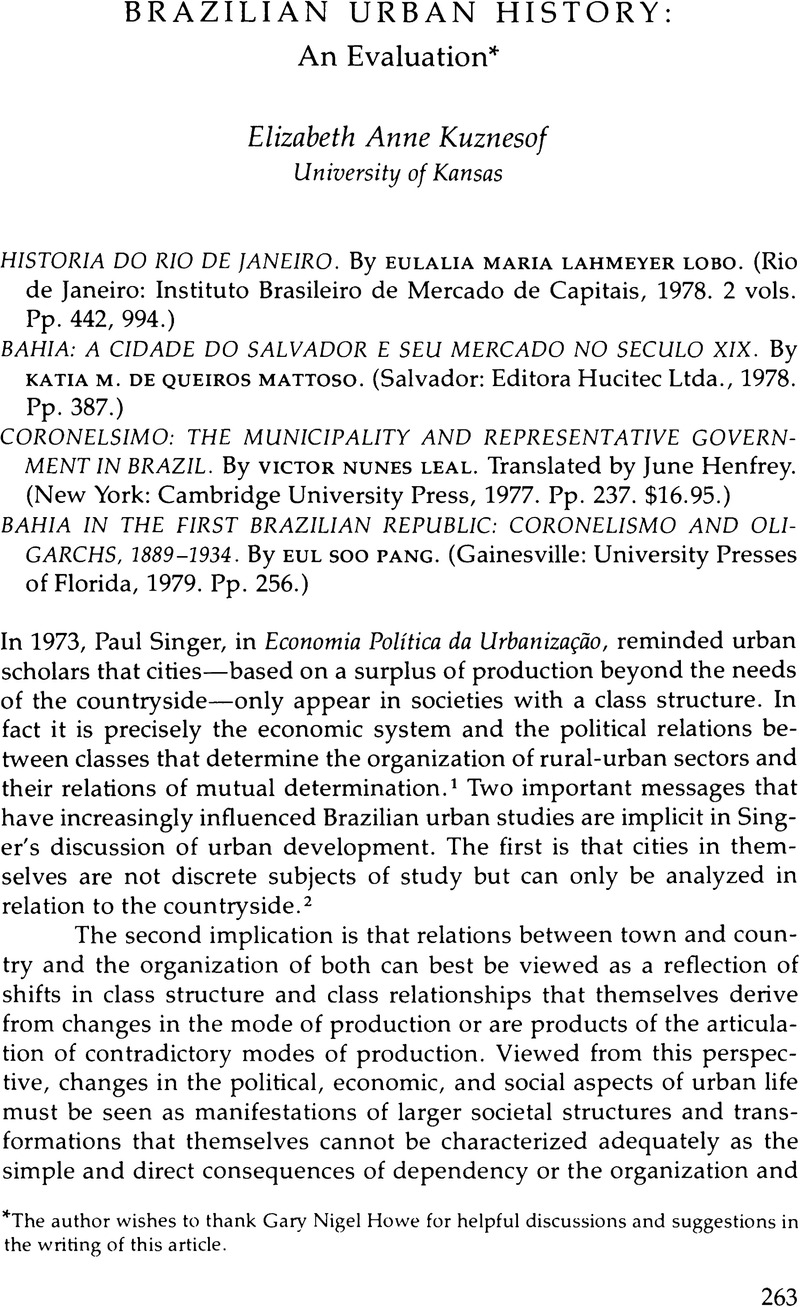No CrossRef data available.
Article contents
Brazilian Urban History: An Evaluation
Review products
Published online by Cambridge University Press: 24 October 2022
Abstract

- Type
- Review Essays
- Information
- Copyright
- Copyright © 1982 by the University of Texas Press
Footnotes
The author wishes to thank Gary Nigel Howe for helpful discussions and suggestions in the writing of this article.
References
Notes
1. Paul Singer, Economia Política da Urbanização (São Paulo, 1973), pp. 11–14.
2. Richard Morse made a similar point in “Trends and Patterns of Latin American Urbanization, 1750–1920,” Comparative Studies in Society and History 16:4 (Sept. 1974), p. 434.
3. Dependency theorists include André Gunder Frank, Capitalism and Underdevelopment in Latin America (New York, 1969); Fernando Henrique Cardoso and E. Faletto, Dependencia e desenvolvimento na América Latina (Rio de Janeiro, 1970); Manual Castells, “La urbanización dependiente en América Latina,” in Castells (ed.), Imperialismo y urbanización en América Latina (Barcelona, 1972); Samir Amin, Accumulation on a World Scale (New York, 1974); and Harold Brookfield, Interdependent Development (London, 1975). Recent criticisms of the uses of dependency theory in urban history include Singer, Economia Política, pp. 63–113; Marcos Kaplan, “La ciudad latinoamericana como factor de transmisión de control socioeconómico y político externo durante el periodo contemporaneo,” Paper for the 39th Congress of Americanists, Aug. 2–9 1970, Lima; Richard M. Morse, “Trends and Issues in Latin American Urban Research (Part II), 1965–1970,” LARR 6:2 (Summer 1971), pp. 50–55; and Anibal Quijano, “The Urbanization of Latin American Society,” in Jorge E. Hardoy (ed.), Urbanization in Latin America: Approaches and Issues (Garden City, 1975), pp. 109–53.
4. Nestor Goulart Reis Filho, Evolução Urbana do Brasil (1500–1720) (São Paulo, 1968) is the most important work demonstrating the political uses of urban planning in the colonial period. Roberta Delson, “Town Planning in Colonial Brazil” (Ph.D. dissertation, Colombia University, 1975) has demonstrated how the same principal of town planning as a means of instituting royal control (or the imposition of order by a local ruling class) continued and expanded in the eighteenth century with the establishment of new towns in the mining region of interior Brazil.
5. Reis Filho, Evolução Urbana, pp. 36–38; Dauril Alden, Royal Government in Colonial Brazil (Berkeley, 1968), pp. 279–87.
6. Charles Boxer, The Golden Age of Brazil (Berkeley, 1975), pp. 106–25; Lahmeyer Lobo, Historia do Rio de Janeiro, p. 26; Rae Flory and David Grant Smith, “Bahian Merchants and Planters in the 17th and Early 18th Centuries,” Hispanic American Historical Review 58:4 (Nov. 1978), pp. 571–94.
7. A. J. R. Russell-Wood, Hidalgos and Philanthropists: The Santa Casa de Misericordia of Bahia, 1550–1755 (London, 1968); Elizabeth Kuznesof, “Clans, the Militia, and Territorial Government: The Articulation of Kinship with Polity in Eighteenth-Century São Paulo,” in David Robinson (ed.), Social Fabric and Spatial Structures in Colonial Latin America (Syracuse, 1979), pp. 181–226 and “The Role of the Merchants in the Economic Development of São Paulo, 1765 to c1850,” Hispanic American Historical Review 60:4 (Nov. 1980); John N. Kennedy, “Bahian Elites 1750–1822,” Hispanic American Historical Review 53:3 (Aug. 1973), pp. 415–39.
8. Richard Morse, “The Development of Urban Systems in the Americas in the Nineteenth Century,” Journal of Interamerican Studies and World Affairs 17:1 (Feb. 1975), pp. 4–26.
9. Warren Dean, The Industrialization of São Paulo, 1880–1945 (Austin, 1969), pp. 67–73; Nicia Vilela Luz, A Luta Pela Industrialização do Brasil (1808–1930) (São Paulo, 1961), pp. 111–16.
10. De Queiros Mattoso, Bahia, pp. 171–74; Elizabeth Kuznesof, “Household Composition and Headship Related to Changes in the Mode of Production: São Paulo 1765–1836,” Comparative Studies in Society and History 22:1 (Jan. 1980), pp. 102–4.
11. Singer, Economia Política, pp. 105–13; Lahmeyer Lobo, Historia, pp. 443–548.
12. The discussion of coronelismo owes much to conversations with Steve Soiffer. For an analysis of coronelismo from this perspective, see Stephen M. Soiffer and Gary N. Howe, “Patrons, Clients, and the Articulation of Modes of Production: An Examination of the Penetration of Capitalism into Peripheral Agriculture in Northeastern Brazil,” unpublished manuscript.
13. Singer, “Migrações Internas: Considerações Teóricas sobre o Seu Estudo,” in Economia Política, pp. 31–60.
14. Nunes Leal, Coronelismo, pp. 88–96, 116–17, 125–29; Raymundo Faoro, Os Donos do Poder (Pôrto Alegre, 1975), pp. 663–79.
15. More recent works on coronelismo include Jean Blondel, As Condições de Vida Política no Estado da Paraíba (Rio de Janeiro, 1957); Faoro, Os Donos; Antonio Barroso Pontes, Mundo dos Coroneis (Rio de Janeiro, 1970); Maria Isaura Pereira de Queiroz, O Mandonismo Local na Vida Política Brasileira (São Paulo, 1960); M. Suxiliadora Ferraz de Sá, Dos Velhos aos Novos Coroneis (Recife, 1974); Celson Jose de Silva, Marchas e Contramarchas do Mandonismo Local (Belo Horizonte, 1975).
16. Faoro, Os Donos and Pereira de Queiroz, O Mandonismo Local utilize especially imprecise definitions of coronelismo.




